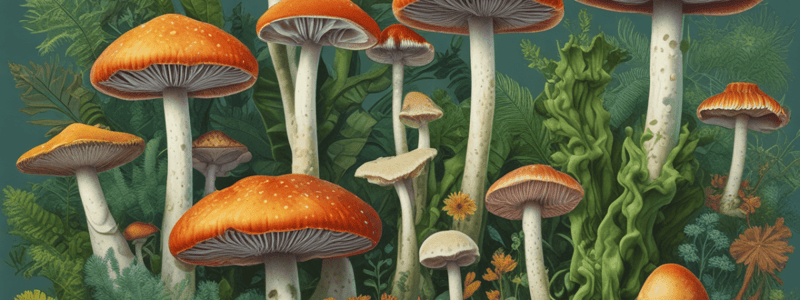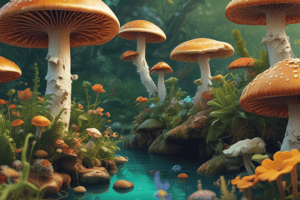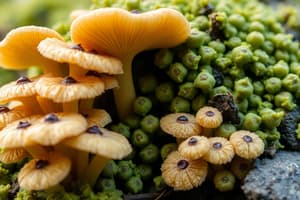Podcast
Questions and Answers
Which of the following statements about fungi is NOT true?
Which of the following statements about fungi is NOT true?
- Fungi can form symbiotic relationships with plants.
- Fungi obtain nutrition by decomposing organic matter.
- Fungi are photosynthetic organisms. (correct)
- Fungi produce spores for reproduction.
What is the primary role of mycorrhizae in the relationship between fungi and plants?
What is the primary role of mycorrhizae in the relationship between fungi and plants?
- The fungi help plants absorb nutrients while receiving sugars produced during photosynthesis. (correct)
- The fungi protect plants from harmful insects and pathogens.
- The fungi provide structural support to the plant's root system.
- The fungi produce hormones that promote plant growth and development.
Which of the following types of fungi is known for its edible fruiting bodies?
Which of the following types of fungi is known for its edible fruiting bodies?
- Molds
- Yeasts
- Spores
- Mushrooms (correct)
What is the primary function of spores produced by fungi?
What is the primary function of spores produced by fungi?
Which of the following statements best describes the relationship between fungi and arthropods?
Which of the following statements best describes the relationship between fungi and arthropods?
Which of the following is NOT a type of fungi mentioned in the text?
Which of the following is NOT a type of fungi mentioned in the text?
What is the primary mode of obtaining nutrition for fungi?
What is the primary mode of obtaining nutrition for fungi?
Which of the following statements about fungi is true?
Which of the following statements about fungi is true?
What is the primary ecological importance of fungi?
What is the primary ecological importance of fungi?
Which of the following statements about the relationship between fungi and plants is false?
Which of the following statements about the relationship between fungi and plants is false?
What is the main difference between the relationship of ambrosia beetles and ambrosia fungi compared to algae and fungi?
What is the main difference between the relationship of ambrosia beetles and ambrosia fungi compared to algae and fungi?
Which statement accurately describes the role of algae in aquatic ecosystems?
Which statement accurately describes the role of algae in aquatic ecosystems?
Which of the following accurately describes the ecological role of fungi?
Which of the following accurately describes the ecological role of fungi?
How do algae differ from fungi in terms of acquiring nutrients?
How do algae differ from fungi in terms of acquiring nutrients?
What is a significant difference between the taxonomy of algae and fungi?
What is a significant difference between the taxonomy of algae and fungi?
In what way do fungi contribute to maintaining balance within their ecosystems?
In what way do fungi contribute to maintaining balance within their ecosystems?
What is a vital task performed by algae in aquatic environments?
What is a vital task performed by algae in aquatic environments?
How do ambrosia beetles differ from algae in their ecological relationships with other organisms?
How do ambrosia beetles differ from algae in their ecological relationships with other organisms?
Which option provides an accurate distinction between the ecological significance of algae and fungi?
Which option provides an accurate distinction between the ecological significance of algae and fungi?
Flashcards are hidden until you start studying
Study Notes
Fungi and algae are two distinct types of organisms that play crucial roles in various ecosystems around the world. While they share some common characteristics, such as being non-motile and lacking chlorophyll in their cells, they have significant differences in terms of structure, function, and ecological importance.
Fungi
Fungi are non-photosynthetic organisms that obtain nutrition primarily by decomposing organic matter, symbiotically with photosynthetic partners or by preying on other living organisms. They possess several unique features that distinguish them from other forms of life. For example, fungi produce spores, which are microscopic reproductive units that can survive harsh environmental conditions and remain dormant until favorable conditions arise once again.
There are many different types of fungi, including yeasts, molds, and mushrooms. Mushrooms are particularly well known for their edible fruiting bodies, which are consumed as food by humans and animals alike. Some species of fungi can form mutually beneficial relationships with plants called mycorrhizae, where the fungi help plants absorb nutrients while receiving sugars produced during photosynthesis.
Some fungi also form symbiotic relationships with insects and other arthropods. These associations can involve mutualistic interactions, where both parties benefit, or exploitative ones, where one organism harms the other. One notable example is the relationship between ambrosia beetles and ambrosia fungi: the beetles carry the fungi into newly excavated galleries in wood, and the fungi provide the beetle larvae with food.
Algae
Algae are another type of non-photosynthetic organisms, but unlike fungi, they contain chloroplasts, which are specialized structures containing chlorophyll and other pigments that enable photosynthesis. This allows algae to convert sunlight, water, and carbon dioxide into glucose and oxygen through the process of photosynthesis. As a result, algae serve as primary producers in aquatic environments, forming the base of marine food chains.
There are thousands of different species of algae, ranging from unicellular planktonic forms to multicellular macroalgal thalluses like kelps. Some algae form mutualistic associations with fungi, forming lichens that can grow on rocks, soil, or dead plant material. In these partnerships, the fungi provide protection and nutrients for the algae, which in turn produce sugars via photosynthesis.
Ecological Importance
Both fungi and algae play essential roles in maintaining balance within their respective ecosystems. Fungi contribute to decomposition processes, breaking down dead plant and animal remains and recycling nutrients back into the environment. Their ability to decompose detritus is so important that it has been estimated that without fungi, forests would take centuries to regrow after disturbances.
Algae, on the other hand, serve as primary producers in many aquatic ecosystems, providing energy for entire food webs. They also play a critical role in carbon sequestration, which helps mitigate climate change by removing carbon dioxide from the atmosphere. Many algae are also used as sources of food for humans and livestock, especially in areas with limited access to terrestrial resources.
In conclusion, while fungi and algae may seem similar due to their non-motile nature, they display vastly different structural, functional, and ecological attributes. Fungi primarily rely on decomposing organic matter to acquire nutrients, while algae utilize photosynthesis to produce carbohydrates and release oxygen. Both groups exhibit diverse taxonomy, with fungi having yeast, mold, and mushroom varieties, and algae encompassing a wide range of single-celled and multi-celled organisms. Moreover, each group contributes significantly to the health and prosperity of their respective ecosystems, ultimately creating a delicate balance that supports a variety of life on Earth.
Studying That Suits You
Use AI to generate personalized quizzes and flashcards to suit your learning preferences.




